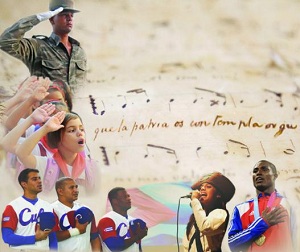 The song of all Cubans, yesterday of Bayamo, today the National Anthem, will always enjoy the greatest respect among the people who sing it with our heads held high and voices afire; because with it we declare our principles, intone our culture, and reaffirm our sovereignty
The song of all Cubans, yesterday of Bayamo, today the National Anthem, will always enjoy the greatest respect among the people who sing it with our heads held high and voices afire; because with it we declare our principles, intone our culture, and reaffirm our sovereignty
Among the dates key to the nation’s founding is October 20, 1868, when the Cuban soul was captured in song, when in a burst of emotion the lyrics of an anthem sounded, like a bugle. Fruit of the independence spirit, La Bayamesa emerged, Martí said, in “the homeland’s most beautiful and solemn hour.”
After defeating the Spanish troops, Céspedes’ men entered Bayamo, the first free city of insurgent Cuba, and in the Plaza Parroquial Mayor, Perucho Figueredo, sitting astride his horse, recited the lyrics for the people around him. “There will be no pen that can describe the delirium, the emotion of that man and that of the people who listened and repeated after him,” his daughter Candelaria recalled.
But the song that identifies us, that makes us proud within and beyond the island, and that as the symbol and essence of our hard-won independence, does not tolerate whispering, has its own story, sometimes eclipsed by the legend of the 20th.
The patriot Francisco Maceo Osorio commissioned Perucho to write the anthem, on August 2, 1867, and 12 days later, he played the music of our “Marseillaise” on the piano at his home, during a meeting of the Revolutionary Committee.
The public premiere took place in Bayamo during the Corpus Christi celebration, June 11, 1868, in the city’s cathedral, and was repeated a second time on Saint Christine’s Day when, in a stroke of audacity, Lieutenant Governor Julián Udaeta himself was obliged to accompany the patriotic melody from his residence in the Philharmonic Society, despite his suspicions.
But it was more beautiful and redeeming when – on the very day of Cubans’ first military and moral victory – the song came to life as an insurgent march, calling the people to take to the battlefield as “the Homeland proudly looks on.”
There are many details of the anthem’s birth to be recalled, like the contribution made by Perucho’s spouse Isabel to the melody, or the more than 20 versions that emerged after the disappearance of the original score, in the Bayamo fire of January 1869, or its reproduction in the newspaper Patria by José Martí, as the highest expression of recognition for an anthem, which was not designated a national symbol until November 5, 1900, during the Constituent Assembly of that time.
Nonetheless, the song of all Cubans, yesterday of Bayamo, today the National Anthem, will always enjoy the greatest respect among the people who sing it with our heads held high and voices afire; because with it we declare our principles, intone our culture, and reaffirm our sovereignty.
(Taken from Granma)